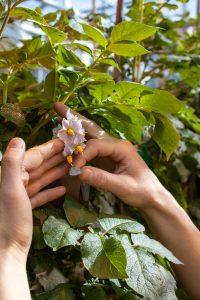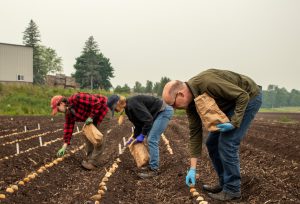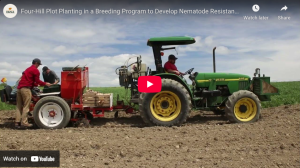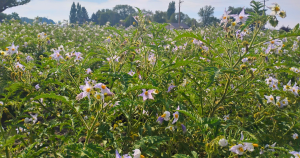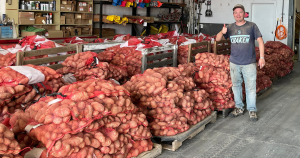Controlling Pale Cyst Nematode with Quinoa
University of Idaho researchers have found planting a niche “superfood” could provide a profitable rotation crop for potato farmers in eastern Idaho who are dealing with an infestation of the devastating, quarantined pale cyst nematode (PCN).
Eastern Idaho has emerged as the nation’s top quinoa producing area, with roughly 3,000 acres of this nutrient-dense crop planted in 2023.
Quinoa, a flowering plant in the amaranth family, works as a “trap crop” by stimulating PCN to hatch in the absence of a viable host. PCN is extremely hard to eliminate from fields. Encysted eggs can remain viable in soil for more than 30 years before hatching when a host plant, such as potato, is planted.
The PCN infestation found in Idaho was discovered in 2006 and, fortunately, has not spread to other potato producing areas in the U.S. but remains contained to approximately 3,500 acres in Bonneville and Bingham counties.
PCN can reduce potato yield by 80% or more depending on the level of infestation. Because of its tremendous economic impact, and the ease in which PCN is spread in infested soil, infested cropland continues to be regulated by USDA’s Animal and Plant Health Inspection Service (APHIS), where it is regularly fumigated and sampled to determine the viability of the PCN population while it is undergoing a deregulation process prior to planting potatoes again.
Louise-Marie Dandurand, a research professor in the Department of Entomology, Plant Pathology and Nematology, and her doctoral student, Paige Hickman, have studied quinoa in potato rotations in their quest to find new, sustainable options for controlling PCN.
Dandurand and Hickman found quinoa reduced viable PCN eggs by 35% to 40% compared with barley. Barley is used as a controlled check in their research because it neither stimulates PCN eggs to hatch nor serves as a host for PCN. When potatoes were planted after a quinoa crop, cyst production was reduced by 38% compared with cyst production in potatoes planted after barley.
Dandurand’s lab has also researched using a plant in the nightshade family, known as litchi tomato, as another trap crop. Litchi tomato has proven to be far more effective against PCN than quinoa, reducing viable eggs by 97% to 99%. However, litchi tomato is thorny and has no harvest value, and precautions must be taken when planting it to prevent its possible escape as a weed.
“I think quinoa would be worth considering, for sure, as it does help reduce PCN populations. However not as much as litchi tomato, but quinoa is a marketable crop, whereas the primary benefit of litchi tomato is to effectively reduce PCN,” said Hickman, who has researched the use of quinoa and litchi tomato as a PCN trap crop for the past four years.
Dandurand opted to study quinoa based on a publication from South America that found certain quinoa varieties induce hatch of PCN. Many PCN eggs don’t hatch when exposed to quinoa, however, and can remain viable until they have access to a suitable host, such as potatoes.
Dandurand believes certain compounds in litchi tomato also kill the PCN eggs that don’t hatch. She has another doctoral student assigned to isolating those compounds in litchi tomato. The compounds could be applied directly to fields for PCN control.
“You won’t get PCN reproduction with quinoa but as far as reducing PCN, if you use it in rotation with potatoes you’ll get some reproduction in potatoes,” Dandurand said. “I think quinoa has potential as a rotation crop, but it probably won’t be as effective to reduce PCN as a fumigant.”
The researchers conducted their trials in an infested field within the quarantine area, taking special precautions to avoid introducing additional PCN. The cysts were confined to buckets, known as microplots, which were buried in the field. They planted quinoa, barley or litchi tomato in microplot trials then transported their soil samples to an APHIS-approved greenhouse in Moscow, where they planted potatoes in them to measure the effects of the different trap crops on PCN survival and reproduction.
In some of the microplot trials, they planted a PCN-resistant potato variety, Innovator. They found no viable encysted eggs in plots in which Innovator was planted following litchi tomato. PCN counts were similar whether plots were planted with barley or quinoa prior to Innovator.
Dandurand plans to conduct future research evaluating how several different quinoa varieties affect PCN hatching. She also would like to study using quinoa in combination with a fumigant.
Thus far, the researchers have evaluated Kailey, a white-kernelled quinoa variety used by Teton Mills, of Idaho Falls.
Wyatt Penfold, a Driggs seed potato farmer and owner of Teton Mills, said growers who raise quinoa can expect returns that are better than barley but less than potatoes, and their yields tend to increase as they gain more experience with raising quinoa. Penfold has been encouraged by the preliminary U of I research findings.
“Quinoa gives farmers an actual crop they can grow and get paid for rather than litchi tomato,” Penfold said. “It would give us more people to grow it, plus it also helps that economy right around Shelley.”


